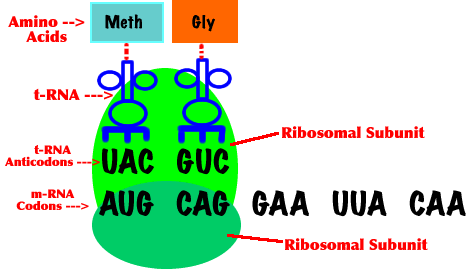tRNA anti-codon (with amino acid) binds to matching mRNA codon

Translocation: Ribosome shifts following 5' to 3' sequence & continues building amino acid polymers (protein), one codon at a time.
Chapter 15
Translation: synthesis of protein by ribosomes . It converts nucleic acid code to amino acid code (hence the term translation).
Anticodon: the 3 nucleotide sequence on t-RNA which the ribosome must fit against m-RNA to ensure that the correct amino acid is placed in the growing protein during translation.
Initiation: Initiates translation. rRNA polymerase of ribosome binds to mRNA strand. 1st tRNA is bonded to mRNA.
Elongation: Ribosome reads mRNA chain in three nucleotide groups (codon) & inserts 2nd tRNA.
tRNA anti-codon (with amino acid) binds to matching mRNA codon
Translocation: Ribosome shifts following 5' to 3' sequence & continues building amino acid polymers (protein), one codon at a time.
Termination: tRNA recognizes release factors of nonsense codon. Newly completed polypeptide is released from ribosome
A Site with a good beginning Animation of Translation (Needs Shockwave)
[Translation Diagram & Description]
1. Universality of Nucleic Acids: All organisms contain nucleic acids. It is a common thread of all life! It's possible to transplant nucleic acids from one species to another as a result!
1. Degeneracy of genetic code: 64 codons possible for 20 amino acids (Ensures several possible codon combinations for each amino acid which helps prevent mutations.) (See Table 15.1)
2. Anticodon & codon both three nucleotides long
3. 45 types of tRNA
4. Much of DNA is filler or non-coding base sequences, not genes
5. Intron: part of gene (DNA or mRNA) that doesn't code for polypeptide (Cut from mRNA & stays in nucleus)
6. Exon: coding part of DNA (or mRNA) exported to ribosome
7. Splicing: as mRNA matures, non-coding (introns) parts are removed (See Figs. 15.17 & 15.18 in text)
8. nonsense (stop) codons on mRNA are UAA, UAG, UGA
9. Start (promotor codon) signal is AUG
10. A gene is a DNA base sequence, a polypeptide is the protein coded by the gene.